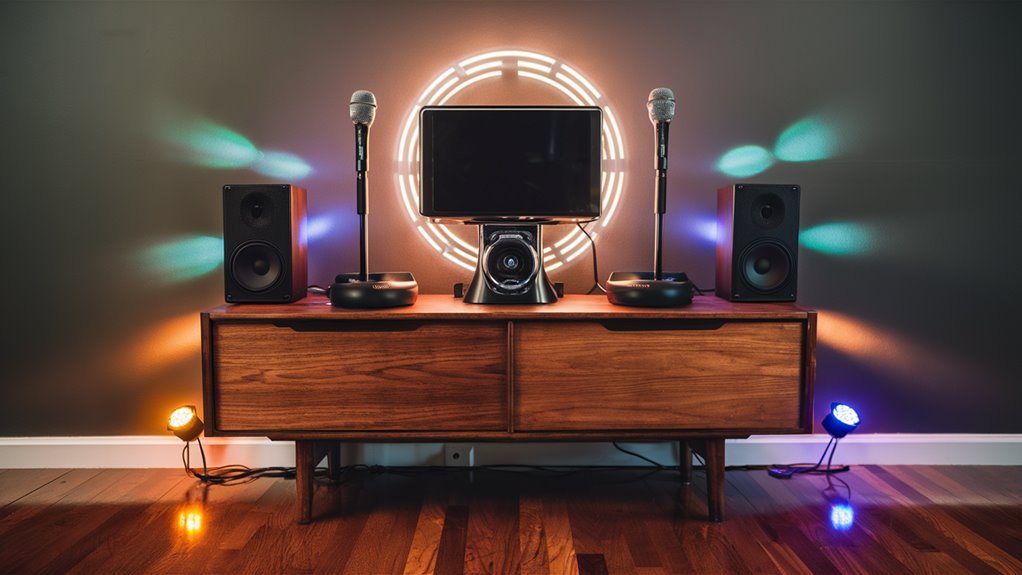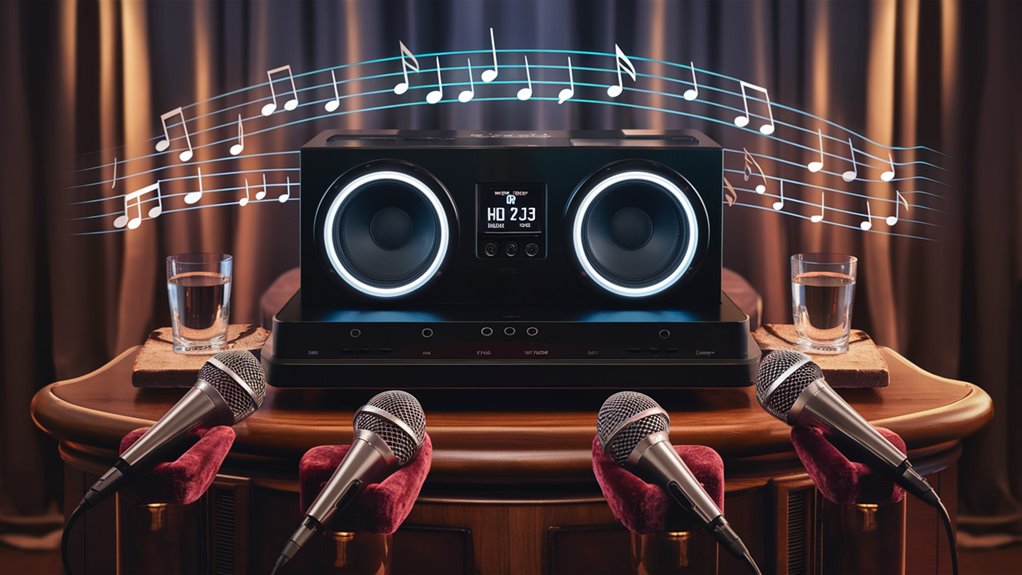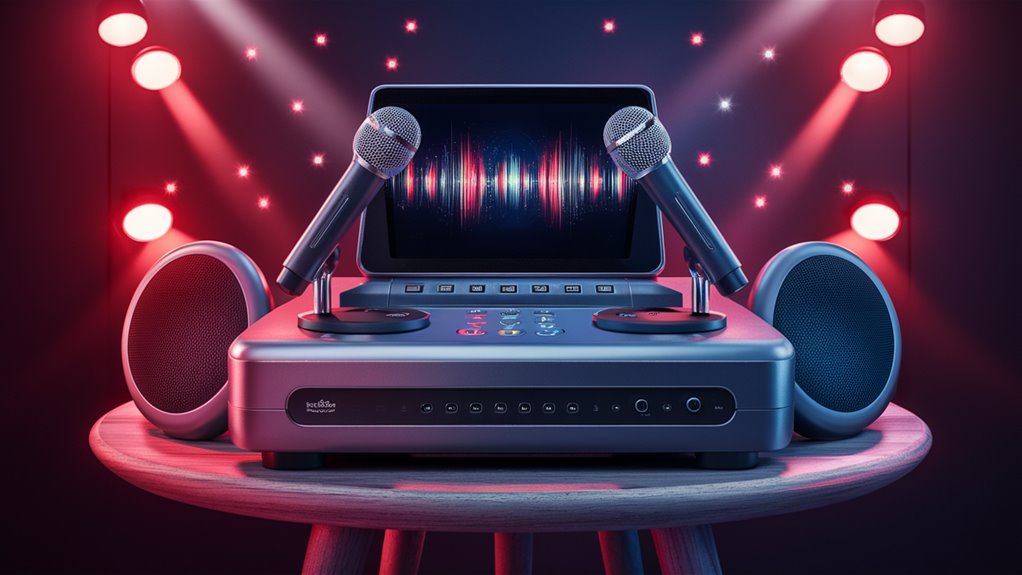Top Karaoke Machines for Parties: Simple Buying Guide

When picking the best karaoke setup for parties, it helps to know the important tech details and traits that bring out top sound. A good setup needs a power of at least 50W RMS for home use, and systems of 100W+ for big rooms for the best sound.
Key Tech Details
The best party karaoke machine has two UHF wireless mics that work between 470-698 MHz, keeping your singing clear of any sound issues. Great sound comes from two speakers with special woofers and tweeters which keep the sound clear from 20Hz-20kHz and keep noise low below 1%.
Connecting with Tech
Good karaoke systems must have many ways to connect:
- Bluetooth 5.0 for easy streaming Karaoke vs. Live Band: Which Experience Is Better for You?
- HDMI for video
- USB-C for more uses
- Many inputs for different sound sources
Best Setup Steps
To really get a pro sound, put your speakers at ear level at a 45-degree angle for best area coverage. Set mic levels to -6dB to stop loud feedback and still keep clear voice sounds. This setup shares sound well in your party area.
What Makes a Great Karaoke Machine
Needed Tech Parts and Details
A top-quality karaoke system needs specific tech parts that affect its performance and make users happy. Power of sound, measured in watts RMS, needs a minimum of 50W for home karaoke and 100W+ for bigger sites. Top speakers should give clear voice sounds (2-4kHz range) while keeping a strong bass sound (60-200Hz).
Pro Audio Traits
Two wireless mics use UHF signals (470-698 MHz) for the best clear voices with no interference. Key voice controls include echo adjust, reverb effects, and pitch fixes you can change as needed. A digital space to hold 16GB or more makes sure you have enough songs and smooth playlist control.
Connect and Display Details
Modern karaoke machines need many ways to connect including Bluetooth 5.0, HDMI, RCA plugs, and USB ports. The screen should be at least 7 inches with a 1024×600 look for clear words. Important output traits include format playing like MP3, MP4, CDG, mic strength (-32dB or more), and a signal-to-noise ratio over 85dB for top sound in both home and big karaoke spots.
Full Karaoke Setup Guide
Top Rated System Tech Details
The KaraokeCloud Pro X3000 leads with 80W RMS power and dual 10-inch woofers, giving top sound. Advanced digital sound tech mixes with quick Bluetooth 5.0 and many choices like HDMI and optic sound outputs for the best work.
Sound and Traits Check
The SingMaster Elite uses its 50W power with modern voice boost tech and built-in pitch fix. Its big 20,000+ song setup and easy use make it a great choice. At the same time, the VocalTech Supreme has a good balance with 65W power and comes with two wireless mics that have their own sound controls for careful sound changes.
Ways to Connect and Sound Checks
Connecting ways change a lot between models. The X3000 excels with USB-C and many other inputs and outputs. The Elite focuses on wireless ways, while the Supreme works well with older types through its CD+G player. Checking sound timing shows key work differences: X3000 (20ms), Supreme (25ms), and Elite (35ms), affecting how singing matches the music and system speed.
Sound and Speakers in Karaoke Setups

Need-to-Know Speaker Details
Sound quality is key in karaoke performance, ranging from simple 20W setups to big 100W systems. Two-speaker setups with special woofers and tweeters offer the best voice clarity and bass, important for both music and live singing.
Performance Marks and Tech Details
Three main marks show top speaker work:
- Frequency range (20Hz-20kHz in good setups)
- Low noise (noise under 1%)
- Signal-to-noise ratio (>90dB)
Built-in digital sound tech and auto sound cut are now common in mid to high-range karaoke sets, making the sound better.
Power Needs and Sound Control
Adjustable sound settings and separate sound levels for music and mic inputs are key for the best output. 50W systems are good for home fun, while big venues need 80W or more. Digital amps give better power use and cleaner sound than old circuits, especially when loud sounds over 85dB are played.
Home vs. Pro Karaoke Tech Details
Sound Power and Speakers
Home karaoke sets often have 25-50 watts RMS with small 4-6″ drivers, made for up to 200 square feet. These systems have simple digital sound tech and Class D amp tech for less power use and little heat.
Pro Site Answers
Big karaoke gear makes 200-500 watts RMS using strong 10-15″ drivers, made for up to 2000 square feet. These tools have advanced sound tech, smart sound cut setups, and dual-channel amps.
Tech Details and Ways to Connect
Inputs/Outputs
- Home Tools: 3.5mm and RCA connections
- Pro Gear: XLR and TRS balanced ways
- Mic Tech: Dynamic vs. condenser choices
- Sound Work: Pro tools have parameter EQ, squeezing, and advanced effects ways
- Format Use: Home tools focus on MP3/Bluetooth, while pro systems handle many digital and old formats
Extra Features
Pro setups stand out with:
- Balanced audio outputs
- Module growth options 호치민 퍼블릭가라오케 예약하기
- Multi-channel mixing choices
- Pro-grade sound work
- Full format use
Full Guide to Setting Up Your Karaoke System
Needed Tool Places
Speaker spots are key for top sound. Place speakers at ear level and angle them 45 degrees toward the singing spot, keeping them 6 feet apart for proper stereo look. Balanced XLR wires should link the mixer’s main outputs to powered speakers, cutting sound issues.
Sound Setup and Mic Setup
Mic levels need careful set-up to peak at -6dB, stopping unwanted loud feedback and sound mess-ups. The sound chain work makes sure you get clean, top-quality sound in your karaoke shows.
Display and Visual Parts
Video screen spots need careful placing at 5-6 feet from the ground, making sure song words are clear from 15-20 feet away. Keep top signal quality through HDMI or VGA ways linking karaoke sources and display tools using top-grade wires.
Sound Best Use and Room Sound
System sound fixing needs careful tuning, focusing on tricky frequencies. Cut around 250Hz to stop muddiness and tweak 2.5kHz to ease harshness. Do full sound path checks to spot any sound loops and tune input/output levels for your room’s special sound needs.
